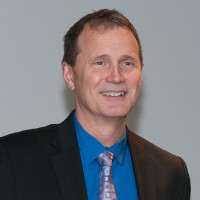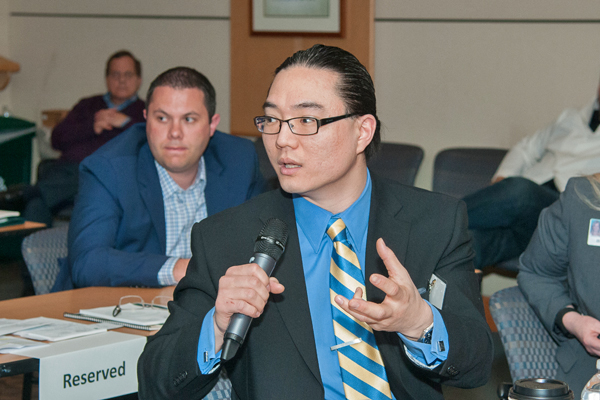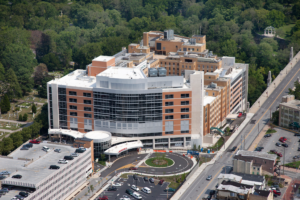What sophisticated resources does a comprehensive stroke center draw upon when combating one of the deadliest and most debilitating medical emergencies?
Answering that question was the central theme of the Third Annual Christiana Care Neurovascular Symposium, April 17 at the John H. Ammon Medical Education Center. A dozen health practitioners from Christiana Care were among the speakers.
“We’re conveying how to care for stroke patients from first ambulance contact to rehab,” said Jason Nomura, M.D., core stroke faculty and Emergency Department physician, and one of the symposium planners.

Program chair Gregg H. Zoarski, M.D., attending physician in Neuro-Interventional Surgery, was excited over this year’s record turnout. Nearly 200 regional health professionals registered for the daylong event to learn evidence-based diagnostic and treatment techniques for helping patients when a blood vessel ruptures in the brain (hemorrhagic stroke) or is blocked by clot (ischemic stroke). With over 20 years of experience in Neuro-Interventional Surgery treating embolic stroke, intracranial aneurysms, brain and spinal vascular malformations, Dr. Zoarski has been an active participant in the evolution of stroke treatment.
“What I didn’t anticipate when I picked the topic of comprehensive stroke center was how rapidly stroke intervention would advance over just the past year,” said Dr. Zoarski. “We now have the results from several excellent randomized controlled studies that prove the benefit of intra-arterial stroke treatment over standard medical therapy. These studies demonstrate less disability and a trend toward lower mortality in ischemic stroke patients after mechanical removal of the arterial blockage.
“This conference highlighted how the new treatments for stroke have sparked an evolution in stroke care, taking it from a ‘chronic disease’ to one that is a ‘treatable emergency’,” said Barbara J. Albani, M.D., medical director of Neuro-Interventional surgery. “We can do things now that were only dreamed of in the past. While we continue to gain momentum with treatment, there is still much that needs to be accomplished in early recognition, so that patients can benefit from these treatment advances, and, most importantly, in prevention, so that stroke becomes a rare disease.”
An important change occurred in May 2014, when the Christiana Hospital was certified as a comprehensive stroke center by The Joint Commission and the American Heart Association/American Stroke Association. This recognition promises the highest standard of care for the 1,200 stroke patients treated each year at Christiana Care.
“This new level of certification recognizes the significant resources in staff and training that comprehensive stroke centers must have to treat complex stroke,” said Mary Ciechanowski, MSN, RN, APRN, ACNS-BC, CCRN, stroke program advanced-practice nurse.
The requirements for a comprehensive stroke center include:
- A neuro-intensive care unit with beds for complex stroke patients, providing neuro-critical care 24 hours a day.
- Use of advanced imaging capabilities.
- Coordination of post-hospital care for patients.
- Use of a peer-review process to evaluate and monitor care for patients with ischemic stroke and brain hemorrhage.
- A commitment to follow evidencebased guidelines and participate in stroke research.
The goal of all stroke treatment is to restore appropriate blood flow to affected areas of the brain as quickly as possible, said Brian King, NREMT-P, FP-C, flight paramedic. He pointed out that stroke onset is typically less dramatic than a heart attack and can easily go unnoticed. Yet strokes are the fifth leading cause of death and the leading cause of disability.
As a paramedic, he’s found the Cincinnati Prehospital Stroke Scale is one of the easiest ways to identify stroke, as it makes use of three diagnostic signs: facial droop, arm drift and altered speech that leaves a person mute or slurring words. “If a patient has one of these there is a 72 percent likelihood of having a stroke,” said King.
After detection, a patient’s speed of arrival in the Emergency Department is a key determinant in treatment options and standard of care, said D. Ethan Kahn, D.O., neurointensivist. In evaluation of stroke, a CT scan is a vital tool for revealing a hemorrhage and showing whether it’s possible to give tissue plasminogen activator (tPA) intravenously to relieve an ischemic stroke.
“At Christiana Care we have a 4.5 hour window for tPA treatment from stroke onset,” said Dr. Kahn. Sudhakar Satti, M.D., associate chief of Neuro-Interventional Surgery, and Thinesh Sivapatham M.D., neurointerventionist, said that within the past year several studies have shown the efficacy of intra-arterial therapies (IAT), which are particularly helpful for patients arriving after the tPA treatment window has closed or when there are other contraindications for tPA. IAT therapies include chemical dissolution of clots with locally delivered thrombolytic agents and clot disruption, or thrombectomy, with a new generation of mechanical devices.
Three trials published in the New England Journal of Medicine (MR CLEAN, ESCAPE, and EXTEND I) recently have shown that ischemic stroke patients with vessel occlusion have positive results if clots are mechanically removed.
“We have waited three decades for trials with randomized control data such as this,” Dr. Satti said. “This has been a huge year for us.”
Other highlights:
Depression and apathy syndrome are common in patients after a stroke and are often related to a patient’s vascular disease, said Christopher Martin, M.D., psychiatrist. In general, a third of patients will have post-stroke depression. The best predictors for depression are the extent of a patient’s physical disability, cognitive impairment, and underlying depression and dysthymia prior to a stroke.
Darcy Reisman, PT, Ph.D., associate professor, University of Delaware Department of Physical Therapy, spoke about brain neuroplasticity and stroke rehabilitation. Research is showing that recovery of motor function is mediated by neuroplasticity, and in physical therapy “use it or lose it” and “use it and improve it” are two phrases that apply. In terms of building neural networks, it’s important to work directly on specific skills. So if you want a patient to walk, a patient should practice walking, she said. In fact, a therapist should ask a patient to repeat individual skills as often as possible. “Changes in the neural map continue even when there is a plateau in behavior,” she said.
A presentation on “Obesity, Weight Loss and Public Health” suggested that many health providers do not see obesity as a disease but as a personal failing. Clinicians haven’t yet offered the most effective therapeutic interventions for most of the 35 percent of Americans struggling with obesity, said Scott Kahan, M.D., MPH, director, National Center for Weight and Wellness, and Medical director, Strategies to Overcome and Prevent (STOP) Obesity Alliance, George Washington University. In his view, a multipronged approach to obesity is needed: Public health officials must work to address the physical and social environment (such as access to healthy foods and junk-food marketing), and clinicians need better education on obesity so they can help patients with options such as bariatric surgery and FDA-approved medications, as well as strategies for diet, exercise and moderate weight loss.



